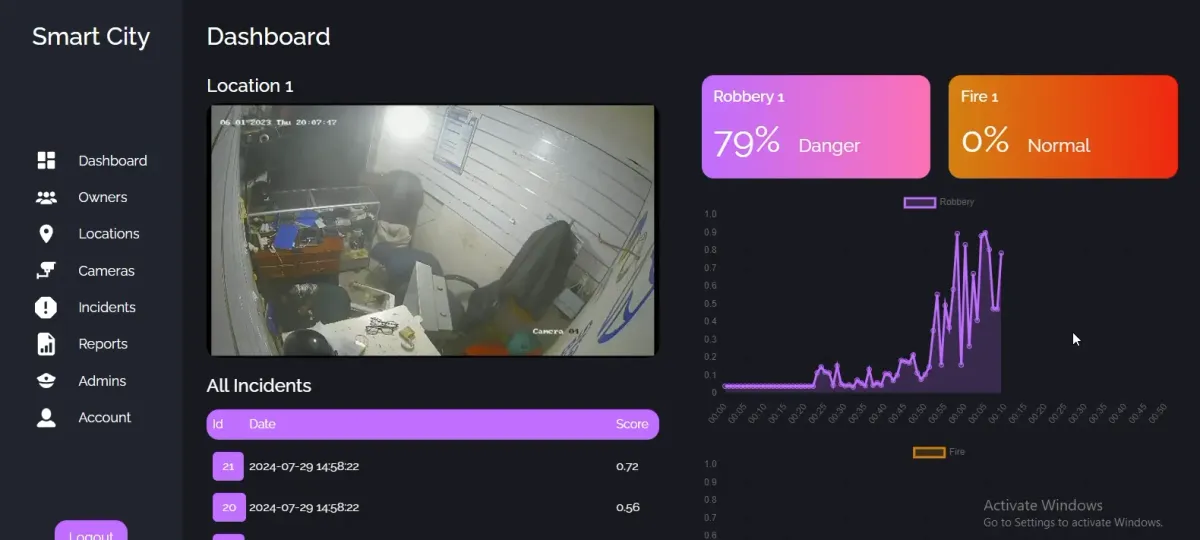Smart City - AI Powerd Robbery and Fire Detection System
Computer Vision system to detect robbery and fire incidents in smart cities

Project Description
Monitoring public locations has become increasingly critical as ensuring public safety and security is a top priority. Surveillance systems are now widely deployed in various public places to identify and respond to abnormal incidents such as robberies and fire outbreaks. However, these traditional surveillance systems rely heavily on manual inspection by human operators, who must maintain constant vigilance over everything captured by surveillance cameras. This task is challenging and prone to human error and fatigue. Therefore, the integration of Artificial Intelligence (AI) is highly recommended to automate this process. By leveraging Computer Vision (CV) and Deep Learning (DL) algorithms, AI can significantly enhance the efficiency and effectiveness of surveillance systems in detecting and responding to unusual activities.
Project Motivation
Due to the rising incidence of robberies and fires in the cities, people in these areas may be at risk and in danger, implementing a cutting-edge fire and robbery detection system can significantly reduce instances of robbery and enhance fire safety. These advanced systems include an alert mechanism that not only notifies the authorities promptly in the event of a fire but also ensures that residents are promptly informed. This proactive approach to safety not only protects the well-being of residents but also addresses several pressing factors that underscore the urgency and necessity of this crucial project:
- Protecting Lives and Property
- Reducing Response Time
- Enhancing Public Safety
- Optimizing Resource Allocation
- Learning from Past Experiences
- Data Privacy and Security
- Advancing Technology and Innovation
- Data-Driven Decision-Making
- Building Community Trust
- Sustainable Development
System Architecture
The system architecture comprises three layers as shown in the figure below. System layers dedicated to processing video frames, generating predictions, displaying results, issuing alerts, and saving results in the database.

User Interface
A responsive website has been developed to display predictions and real-time system status, allowing users to view recent incidents and reports, as well as add new users to the system. Access to the user interface and system controls is restricted to authorized administrators.
Application Layer
In this layer, the system initiates by capturing frames from the video source. These frames undergo a sequence of processing stages: Preprocessing, Feature Extraction, Model Training, and Model Evaluation. Each of these stages will be comprehensively explained in the following sections.
Frame Extraction:
In this step, frames are extracted from a live video stream and passed to the next step.
Preprocessing:
The extracted frames undergo preprocessing, such as resizing, to prepare them for subsequent steps.
Feature Extraction:
A pre-trained feature extractor is used to extract meaningful features from the frames. Multiple feature extractors are employed in this step, such as C3D and NasNetMobile. This step ensures that the model focuses on the most important aspects that will aid in making accurate predictions.
Robbery and Fire Detection Models Training Using CNN:
A well-designed CNN is trained on the extracted features to generate predictions, utilizing a combination of convolution, pooling, and LSTM layers. This step ensures that the model can generalize effectively to predict new inputs.
Model Evaluation
Finally, the predictions are evaluated to ensure accuracy and reliability. The model is then fine-tuned to achieve better results.
Backend Layer:
In the backend layer, prediction results are processed, and decisions are made to save any captured incidents. System alerts administrators through various channels, such as emails and Telegram messages. Additionally, the system generates periodic reports summarizing the system's status over specific periods. Authorization is managed to ensure that only authorized administrators can view the system status, incidents, and reports.
Database Layer
In this layer, captured incidents, reports, and user data are stored in a database, ensuring that these results can be accessed and reviewed later.
Project Demo
Project Team
- Seif Omran
- Seif Samer
- Seif Ezz
- Seif Wael
- Nouran Tarek
- Aya Gamal



